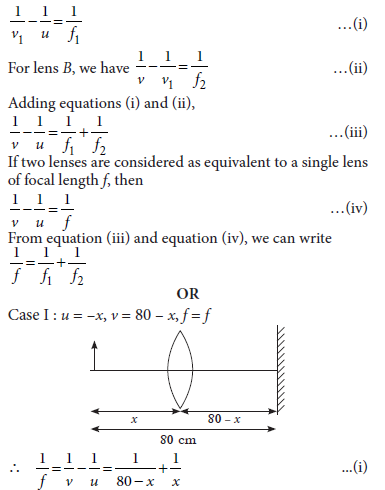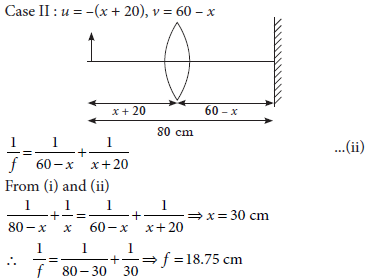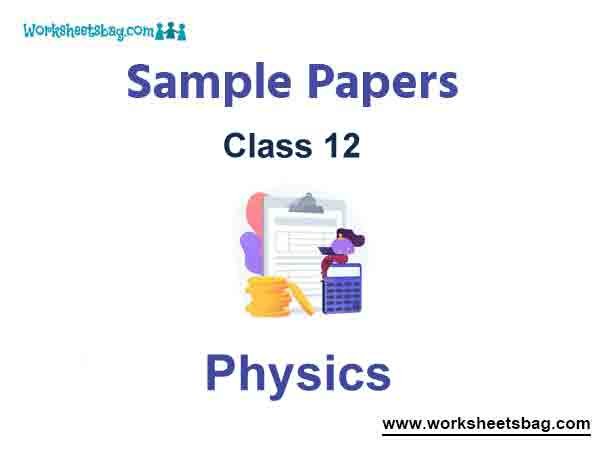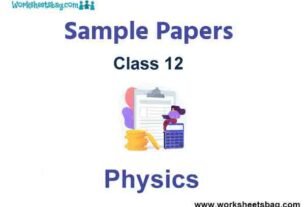Please refer to Class 12 Physics Sample Paper Term 2 Set A with solutions below. The following CBSE Sample Paper for Class 12 Physics has been prepared as per the latest pattern and examination guidelines issued by CBSE. By practicing the Physics Sample Paper for Class 12 students will be able to improve their understanding of the subject and get more marks.
CBSE Class 12 Physics Sample Paper for Term 2
1. Write the relation between the refractive index and critical angle for a given pair of optical media.
OR
State the condition for total internal reflection.
Answer: aμb = 1/sin C’
, where a and b are the rarer and denser media respectively and C is the critical angle for the given pair of optical media.
OR
(a) Conditions for total internal reflection are
(i) Light must travel from denser to rarer medium.
(ii) Angle of incidence must be greater than critical angle.
2. Arrange the following materials in increasing order of their resistivity.
Nichrome, Copper, Germanium, Silicon
Answer: Materials Resistivity (Ρ) (Ω m at 0°C)
Copper (Cu) Nichrome 1.7 × 10–8
(alloy of Ni, Fe, Cr) 100 × 10–8
Germanium 0.46
Silicon 2 300
3. In the circuit shown if drift current for the diode is 20 mA, find the potential difference across the diode.
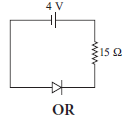
Show the variation of resistivity of Si with temperature in a graph.
Answer: (c) : Since the diode is reversed biased, only drift
current exists in circuit which is 20 μA.
Potential drop across 15 Ω resistor
= 15 Ω × 20 μA = 300 μ V = 0.0003 V
Potential difference across the diode
= 4 – 0.0003 = 3.99 ; 4V
OR
The variation of resistivity of Silicon (Si) with temperature is shown as
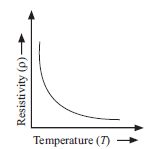
4. Is the ratio of number of holes and number of conduction electrons in a p-type semiconductor more than, less than or equal to 1?
Answer: The ratio of number of holes and number of conduction electrons in a p-type semiconductor is more than 1.
5. The circuit shown in the figure has two oppositely connected ideal diodes connected in parallel. Find the current flowing through each diode in the circuit.
Answer: Diode D1 is reverse biased, so it offers an infinite resistance. So no current flows in the branch of diode
D1.
Diode D2 is forward biased, and offers negligible resistance in the circuit. So current in the branch
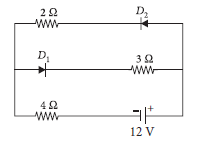
For question numbers 6-7 two statements are given-one labelled Assertion (A) and the other labelled Reason (R).
Select the correct answer to these questions from the codes (a), (b), (c) and (d) as given below.
(a) Both A and R are true and R is the correct explanation of A
(b) Both A and R are true but R is not the correct explanation of A
(c) A is true but R is false
(d) A is false and R is also false
6. Assertion (A) : Velocity of light is different in different media.
Reason (R) : Light is an electromagnetic wave whose velocity in a medium depends on refractive index of the medium.
Answer: A
7. Assertion (A) : V – I characteristic of p-n diode is same as that of any other conductor.
Reason (R) : p-n diode behave as conductor at room temperature.
Answer: D
SECTION – B
8 is a Case Study based question and it is compulsory. Attempt any 4 sub parts from this question. Each part carries 1 mark.
Photoelectric Emission
Answer: When light of sufficiently high frequency is incident on a metallic surface, electrons are emitted from the metallic surface. This phenomenon is called photoelectric emission. Kinetic energy of the emitted photoelectrons depends on the wavelength of incident light and is independent of the intensity of light. Number of emitted photoelectrons depends on intensity. (hu – Φ) is the maximum kinetic energy of emitted photoelectrons (where f is the work function of metallic surface). Reverse effect of photo emission produces X-ray. X-ray is not deflected by electric and magnetic fields. Wavelength of a continuous X-ray depends on potential difference across the tube. Wavelength of characteristic X-ray depends on the atomic number.
(i) Einstein’s photoelectric equation is
(a) Emax = hu – Φ
(b) E = mc2
(c) E2 = p2c2 + m0 2c4
(d) E = 1/2mv2
Answer:
A
(ii) Light of wavelength l which is less than threshold wavelength is incident on a photosensitive material. If incident wavelength is decreased so that emitted photoelectrons are moving with some velocity then stopping potential will
(a) increase
(b) decrease
(c) be zero
(d) become exactly half
Answer:
A
(iii) When ultraviolet rays incident on metal plate then photoelectric effect does not occur, it occur by incident of
(a) Infrared rays
(b) X-rays
(c) Radio wave
(d) Micro wave
Answer:
B
(iv) If frequency (u > u0) of incident light becomes n times the initial frequency (u), then K.E. of the emitted photoelectrons becomes (u0 threshold frequency).
(a) n times of the initial kinetic energy
(b) More than n times of the initial kinetic energy
(c) Less than n times of the initial kinetic energy
(d) Kinetic energy of the emitted photoelectrons remains unchanged.
Answer:
B
(v) A monochromatic light is used in a photoelectric experiment. The stopping potential
(a) is related to the mean wavelength
(b) is related to the shortest wavelength
(c) is not related to the minimum kinetic energy of emitted photoelectrons
(d) intensity of incident light.
Answer:
B
SECTION – C
All questions are compulsory. In case of internal choices, attempt anyone.
9. In a certain double slit experimental arrangement, interference fringes of width 1 mm each are observed when light of wavelength 5000 Å is used. Keeping the setup unaltered, if the source is replaced by another of wavelength 6000 Å, then find the fringe width.
OR
A parallel beam of light of 500 nm falls on a narrow slit and the resulting diffraction pattern is observed on a screen 1 m away. It is observed that the first minimum is at a distance of 2.5 mm from the centre of the screen.
Calculate the width of the slit.
Answer:
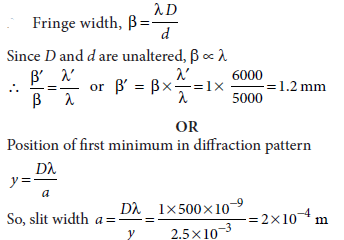
10. Name the parts of the electromagnetic spectrum which is
(a) suitable for radar systems used in aircraft navigation.
(b) used to treat muscular strain.
Answer: (a) Microwaves are suitable for radar systems
used in aircraft navigationThese waves are produced by special vacuum tubes,namely klystrons, magnetrons and Gunn diodes.
(b) Infra-red waves are used to treat muscular pain.
These waves are produced by hot bodies and molecules.
11. Draw the output waveform across the resistor.
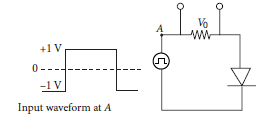
OR
Three photo diodes D1, D2 and D3 are made of semiconductors having band gaps of 2.5 eV, 2 eV and 2.75 eV,
respectively. Which ones will be able to detect light of wavelength 5500 Å?
Answer:

The diode acts as half wave rectifier, it offers low resistance when forward biased and high resistance when reverse biased.
OR
We know that, energy of incident photon
E=hc/λ
λ=6000Å=600nm(given)
E=1242eVnm/550nm=2.25eV
D2 will detect these radiations because energy of incident radiation is greater than the band gap.
12. State the process responsible for energy generation in Sun. Why such process is difficult to achieve an Earth.
Answer: Nuclear fusion is responsible for energy generation in the Sun. For fusion, temperature of 107 K is required, such a temperature is difficult to achieve.
SECTION – D
All questions are compulsory. In case of internal choices, attempt any one.
13. (a) Two slits in Young’s double slit experiment are illuminated by two different lamps emitting light of the same wavelength. Will you observe the interference pattern? Justify your answer.
(b) In Young’s double slit experiment using monochromatic light of wavelength λ, the intensity of light at a point on the screen where path difference is λ, is K units. Find out the intensity of light at a point where path difference is λ/3.
Answer: (a) Two different lamps emit light waves which are not coherent, as they are not in same phase or not have stable phase difference. Due to this, no sustained interference pattern can be obtained on screen.
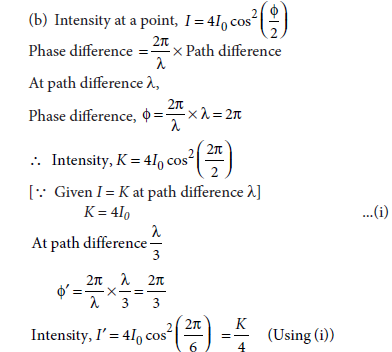
14. Use the lens equation to deduce algebraically:
(a) An object placed within the focus of a convex lens produces a virtual and enlarged image.
(b) A concave lens produces a virtual and diminished image independent of the location of the object.
OR
A convex lens of focal length 20 cm is placed coaxially with a convex mirror of radius of curvature 20 cm. The two are kept at 15 cm from each other. A point object lies 60 cm in front of the convex lens. Draw a ray diagram to show the formation of the image by the combination. Determine the nature and position of the image formed.
Answer:

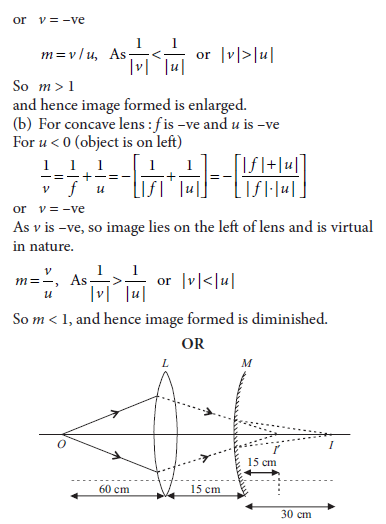

Final image is formed at the distance of 30 cm from the convex mirror (or 45 cm from the convex lens) to the right of the convex mirror.
The final image formed is a virtual.
SECTION – E
All questions are compulsory. In case of internal choices, attempt any one.
15. Using Bohr’s postulates, derive the expression for the frequency of radiation emitted when electron in hydrogen atom undergoes transition from higher energy state (quantum number ni) to the lower state, (nf). When electron in hydrogen atom jumps from energy state ni = 4 to nf = 3, 2, 1. Identify the spectral series to which the emission lines belong.
OR
(i) In hydrogen atom, an electron undergoes transition from 2nd excited state to the first excited state and then to the ground state. Identify the spectral series to which these transitions belong.
(ii) Find out the ratio of the wavelengths of the emitted radiations in the two cases.
Answer:
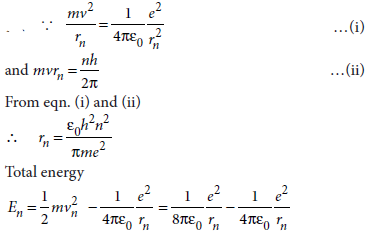
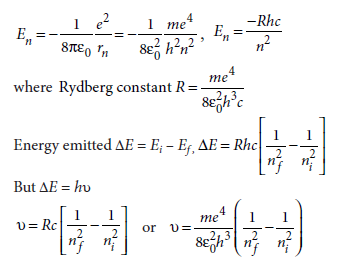
When electron in hydrogen atom jumps from energy
state ni = 4 to nf = 3, 2, 1, the Paschen, Balmer and Lyman
spectral series are found.
OR
(i) An electron undergoes transition from 2nd excited
state to the first excited state is Balmer series and then
to the ground state is Lyman series.
(ii) The wavelength of the emitted radiations in the two
cases.
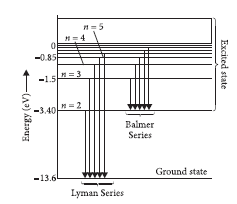

16. Define power of a lens. Write its units. Deduce the relation1/f=1/f1+1/f2
for two thin lenses kept in contact coaxially.
OR
A screen is placed 80 cm from an object. The image of the object on the screen is formed by a convex lens placed
between them at two different locations separated by a distance 20 cm. Determine the focal length of the lens.
Answer: Power of lens : It is the reciprocal of focal length of a lens.

Unit of power of lens : Dioptre
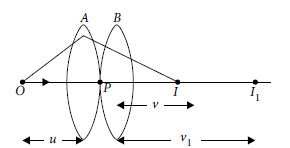
An object is placed at point O. The lens A produces an image at I1 which serves as a virtual object for lens B which produces final image at I.
Given, the lenses are thin. The optical centres (P) of the lenses A and B coincide with each other.
For lens A, we have
